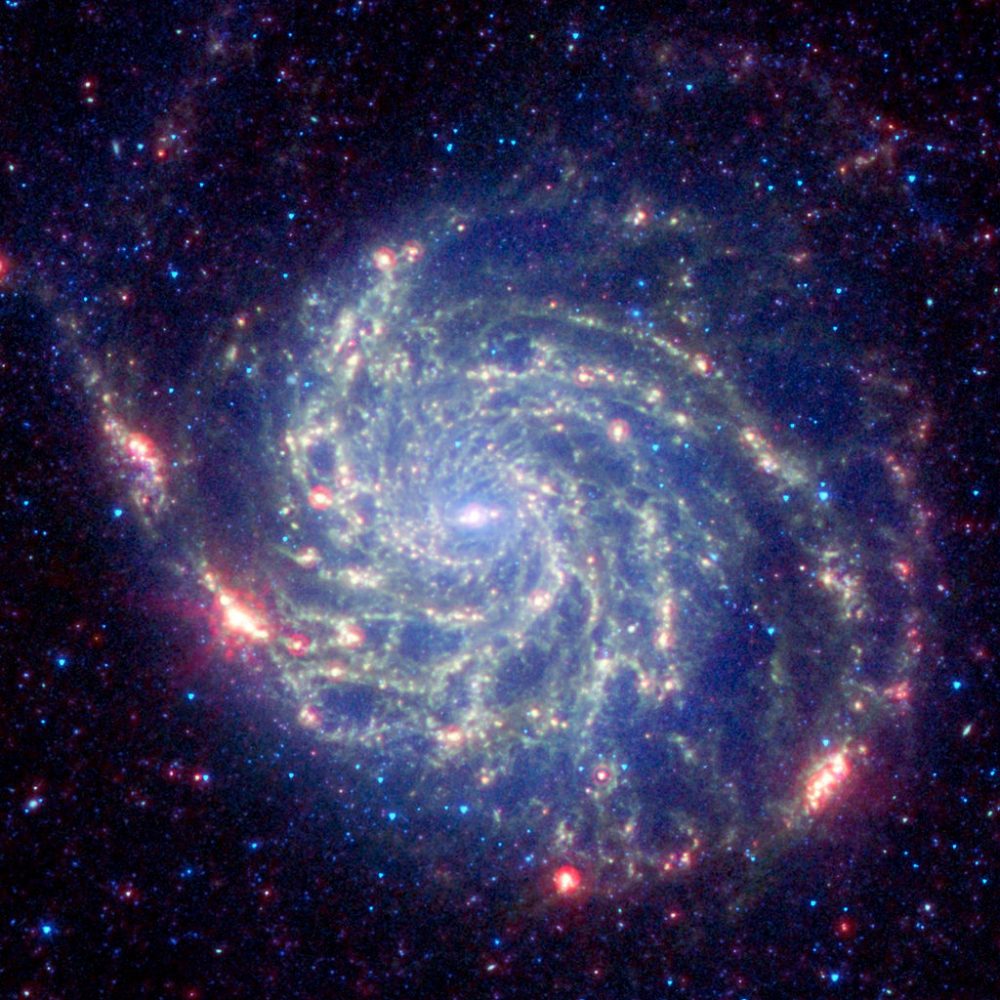Wow, we're having a galactic bonanza here lately! I can't believe it!
I'll try to compare NGC 6744 with some of the other galaxies that have had their own APODs lately. But first. let's look at NGC 6744 itself.
NGC 6744 in optical light.
Photo: Don Goldman.
NGC 6744 in infrared light. Photo: WISE/NASA/JPL-Caltech/UCLA
In infrared pictures of galaxies, blue areas mean red stars. Blue stars, by contrast, hardly show up in infrared images and are mostly invisible there. Green areas in this infrared image mean warm dust. Red-orange areas typically mean ongoing star formation. You can see a few bright orange-red splotches scattered in or near the interface between the inner, slightly yellow arm system, and the outer blue (or, in the WISE image, the green) one. (Note that the outermost blue arm of NGC 6744 and the little companion galaxy at 7 o'clock are mostly invisible in the WISE image.)
All but one of these orange splotches correspond to pink emission nebulas in Don Goldman's image, confirming the fact that these are sites of ongoing star formation. I must wonder what the brightest, reddest, roundest object is, at 2 o'clock. It doesn't correspond to any emission nebulas.
NGC 6744 in ultraviolet light. Photo: NASA/GALEX.
Let's look at one more picture of NGC 6744, this time showing the galaxy in ultraviolet light. Please note that this picture is upside down compared with the other two.
Note that the entire galaxy except the innermost center is glowing white to whitish-blue from ultraviolet light. The color is due to a mixture of stars of different temperatures. (Check out the full resolution
900 Kb image here.) Much of the ultraviolet light seen here is likely produced by relatively modest stars like
Regulus, or even
Vega or
Sirius. Note that you can see the arm pattern of NGC 6744 exceptionally well. You can't spot the sites of star formation, however.
M101 in infrared light. Note the massive sites of star formation.
Photo: Spitzer.
How big is NGC 6744? It's big. Big. If it is 175,000 light-years in diameter, as today's caption says, then it is the same size as (or just possibly even somewhat bigger than) M101. And M101 is simply gigantic!
But M101 is a blue galaxy, dominated by flamboyantly hot, bright blue stars. Its B-V index is 0.450, which is tremendously blue. NGC 6744 is a much redder galaxy. Its B-V index hasn't been measured in the same way as that of M100, so some fits and guesses must be made, but it seems likely that it might be around 0.750 or 0.800, which is much redder.
To be so much redder, NGC 6744 must contain huge numbers of old red and yellow stars. In all probability, the wealth of small red stars in NGC 6744 means that it contains more stars than M101. NGC 6744 is likely also more massive than M101, since the copious numbers of small red stars add a lot of mass to NGC 6744.
So all in all, NGC 6744 is older, redder, more settled and more tired than M101, and, in my opinion, probably more massive. The Pinwheel galaxy, by contrast, is windblown, blue, brilliant and bellowing.
Ann
 Spiral Galaxy NGC 6744
Spiral Galaxy NGC 6744


